Tectonics Research
Our tectonics research spans multiple scales and invariably has societal relevance. On the macroscale, we focus on understanding how sedimentation patterns and pre-existing structures influence strain localization and the developing of various faulting geometries in space and time. On the micro- and mesoscale, we study how grains, fractures, and plasticity influence the earthquake cycle. Browse some of our projects below!
[Paper]
[Lead Author: Vashan Wright]
Tectonics in Southeast Jamaica (Figure 1) is poorly understood, but the region may contain currently unknown faults that could generate large‐magnitude earthquakes. This study constrains tectonics in Southeast Jamaica by collecting and analyzing seismic and shallow sediment core data in and around Kingston Harbor. Seismic results reveal a previously unrecognized strike‐slip fault system that accommodates strain via a complex mix of compression and extension. The faults appear to be a blind extension of one major fault (i.e., The Bull Bay Strike‐Slip Fault) within the Enriquillo‐Plantain Garden Fault Zone. This fault system may represent significant hazards to Kingston Jamaica because the fault is active, located less than 5 km from the city, and a complete rupture of the fault could generate a Mw 5.8–6.9 earthquake. The analyses highlight the need for continued paleoseismic studies, both onshore and offshore Jamaica.
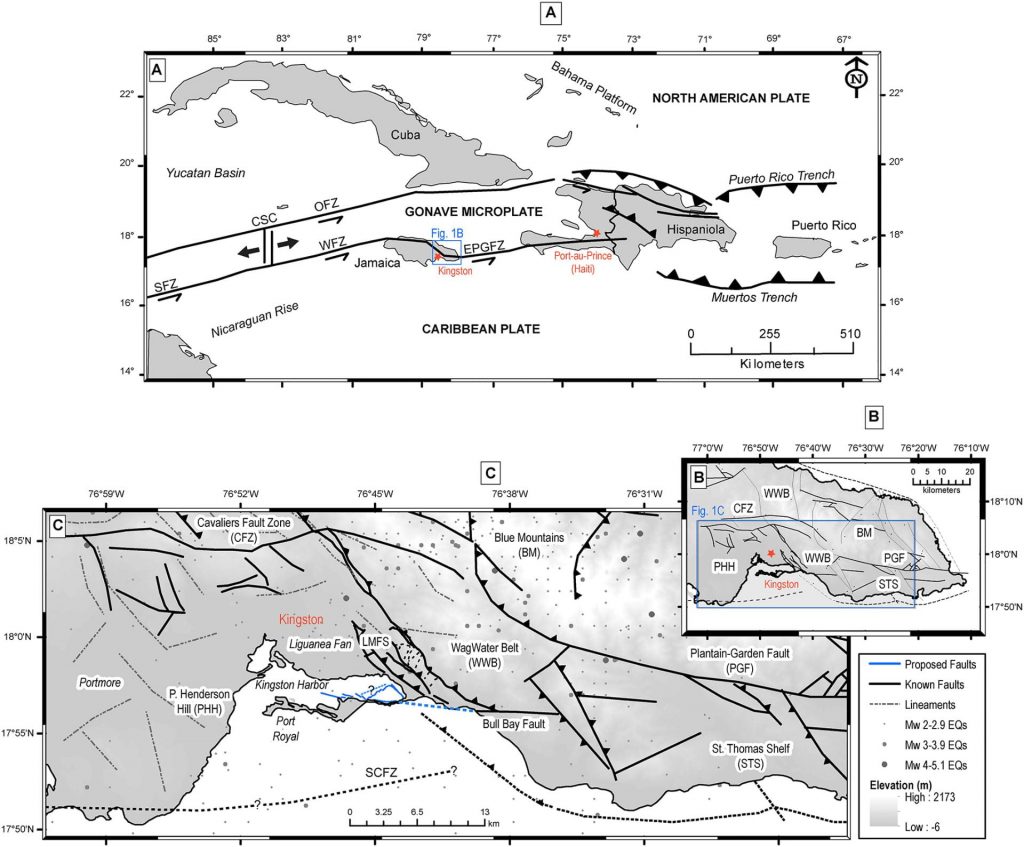
Figure 1. (a) Regional map shows that Jamaica is bisected by the Caribbean Plate and the Gonave Microplate. The country experiences intraplate shearing as a result. Map also shows the locations for the major plates in the region. These plates are bounded by the Enriquillo‐Plantain Garden Fault Zone (EPGFZ), the Walton Fault Zone (WFZ), the Oriente Fault Zone (OFZ), and the Cayman Spreading Center (CSC). (b) Map of Eastern Jamaica showing the locations of mapped faults and major tectonic structures that create the restraining bend flower structure. The abbreviation LMFS refers to the Long Mountain Fault System, which comprises of the Long and Dallas Thrust Mountains (see Figure 2a). (c) The figure is a more zoomed‐in map (blue box in Figure 1b), showing the faults, lineaments, and earthquakes locations in the region.
[Lead Author: Vashan Wright]
Lake level elevation at Lake Enriquillo and Lake Azuei, the two largest lakes in Hispaniola and in the Caribbean, respectively rose by 10 m and 5 m between 2004 and 2013 (Figure 1). Higher lake levels submerged towns, road systems, agricultural lands, and utilities, and threatened to submerge the major overland highway that connects the Dominican Republic and Haiti. This study used CHIRP seismic data, satellite imagery, and regional meteorological data to quantify and assess controls on lake level rises. The result showed that increases in hurricane activity and basin-wide hydraulic connectivity is the likely cause. I, along with my co-authors, propose that the lakes also experience intermittent periods of hydraulic connectivity along reactivated or newly developed stratigraphic-controlled sub-surface transport pathways. We also note that moderately small earthquakes along the large active fault system that extends through both lakes may promote or limit hydraulic conductivity on decadal or shorter time scales. The extents to which recent earthquakes have triggered changes in groundwater flow at this site remain unclear but represents an important topic of future research.
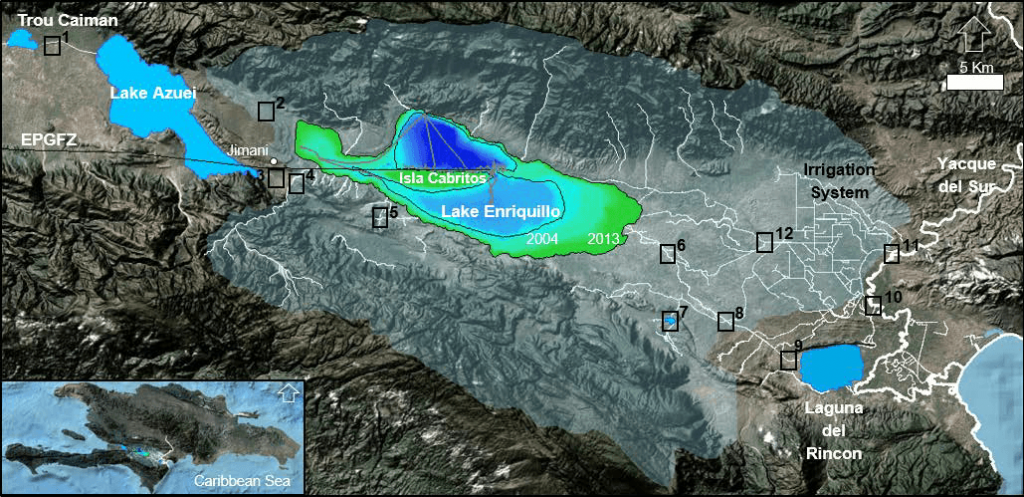
Figure 1. A map that focuses on Lake Enriquillo’s drainage basin and the hydrologic connection between the water bodies within and outside of the basin. Waterbody locations that have undergone hydrologic changes since 2003 are boxed and numbered; white lines indicate streams or man-made channels; gray lines within the lakes are the seismic track lines. The map also shows the pattern of the lake’s areal growth since 2004 and the location of the Enriquillo-Plantain Garden Fault zone (EPGFZ). Since 2004 the lake has grown significantly more easterly or westerly than northerly or southerly.
[Lead Author: Vashan Wright]
Continental erosion rates influence mountain formation and destruction, the filling of sedimentary basins, ocean chemistry, and the concentration of carbon dioxide in the atmosphere. Despite its importance for these and other geologic processes, a clear understanding of the primary drivers of continental erosion remains elusive. Currently debated drivers of continental erosion include changing tectonic activity, precipitation, temperatures, and glacioeustasy. The goal of this work to discuss the role of each geologic process in controlling long-term (Cenozoic-present) continental erosion and the flux of sediment entering the South China Sea (Figure 1), which encompasses only 0.9% of the global ocean area but holds 5.5% of its sediments. Ongoing results from this work demonstrate that continental erosions rates were high during the early-middle Miocene, middle Miocene, Pliocene, and Pleistocene due to the uplift of the Tibetan Plateau, changes from predominantly weak to strong Asian summer monsoon, and global glacial cycles respectively.
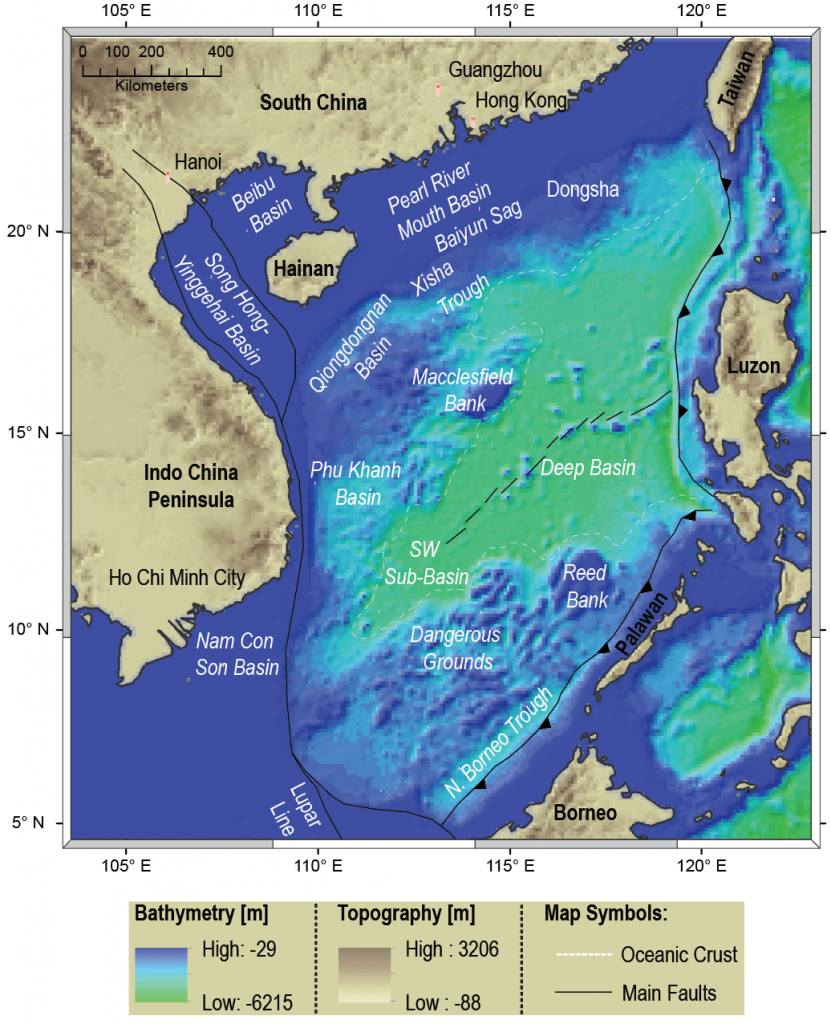
Figure 1. Map of the South China Sea highlighting the main sub-basins and fault structures within the sea.
[Lead Author: Vashan Wright]
The Okavango Rift Zone (ORZ) and Okavango Delta (OD) in Northwest Botswana are Earth’s youngest continental rift system and largest inland delta. The delta and its underlying sediments record the effects of incipient rifting on the geomorphology and stratigraphy within the (incipient) southwestern arm of the East African Rift System in Botswana. The goal of this project is to determine if, how, and under what conditions far-field paleoclimate modulated sedimentation rates and patterns exert control on tectonic strain localization and fault development during the earliest stages of continental rifting, using the Okavango-Makgadikgadi Delta Complex in Botswana (Figure 1) as an example. Apart from providing insights into how rifts initiate, an additional benefit of this work is that it is expected to provide insights into the influence of paleoclimate changes on early hominid migration in Southcentral Africa.
Three open questions that we use river-borne seismic-reflection profile analyses to answer so far are (1) whether the Gumare fault extends across the delta, (2) whether the Gumare fault zone is a part of the ORZ, and (3) how wide is the ORZ. Our results suggest that the Gumare fault extends across the delta and is a part of the ORZ. Integration of our and pre-existing geophysical data also suggests that the southern section of the ORZ is more active than the northern section that we imaged, and at least 150 km of fault-related extension has occurred within the Okavango Rift Zone. These findings provide constraints on the present-day structural and stratigraphic configuration of the ORZ and OD, which is a fundamental first step towards reconstructing sedimentation and extensional patterns during the earliest stages of continental rifting.
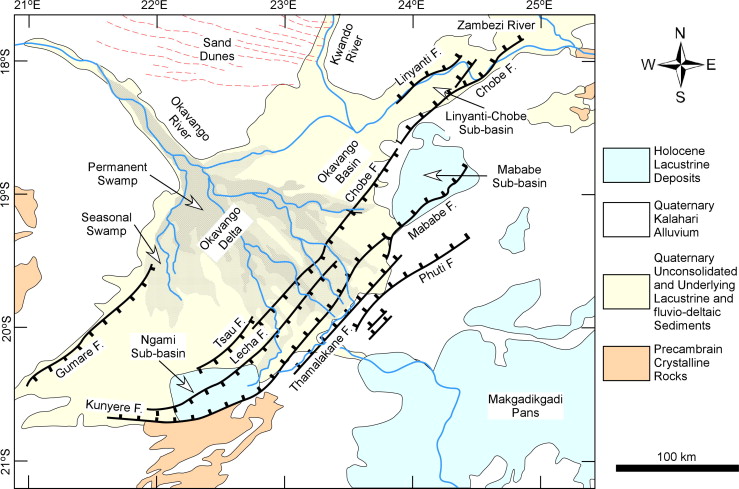
Figure 1. Map from Bufford et al., (2012, Journal of African Earth Sciences) showing a proposed fault model for the Okavango Rift Zone, based on magnetotelluric and electrical resistivity tomography imaging. I am in the process of imaging the rift zone using seismic reflection profiles, which provides a clearer picture of where faults extend within the rift zone.
[Lead Author: Jhardel Dasent]
Several questions about relationships between unconsolidated fault zone grains and tectonic shearing remain to be ground-truth with field data. Can we distinguish between co-seismic and aseismic shearing of natural grains? How does shearing influence natural grains' strength, friction, and jamming? Does shearing-induced grain deformation correlate with earthquake magnitude and slip rate? Answers to these questions may provide new ways to extend the paleoseismic records of exposed faults while providing insights into how natural near-surface fault zone grains influence earthquake nucleation, and the spatial distribution of deformation. We are making progress in answering the above-mentioned questions by quantifying the deformation of unconsolidated fault zone grains in thirty 2 cm long by 1 cm wide cores sampled to minimize disturbance. We sampled exposed sand layers from two locations on the Southern San Andreas Fault and one from the Northern San Gregorio Fault. At Pallett Creek, we examine samples from inside and outside the main fault zone that have experienced shear from 4 and 7 earthquakes > M6. From Ferrum, we examine samples that have experienced only creep and 1 earthquake > M6. At Half Moon Bay, we examine samples that have experienced shear during 1 earthquake > M7. To date, we have acquired x-ray microtomographic images of the samples and observed the following: fractured grains existing in co-seismically sheared samples not observed in sands outside a fault zone (Figure 1). Grain breakage due to tectonic shear is a prediction from laboratory and numerical studies of fault gouge deformation. Future work will quantify grain and pore properties and use the results to continue the search for commonalities deriving from tectonic shear.
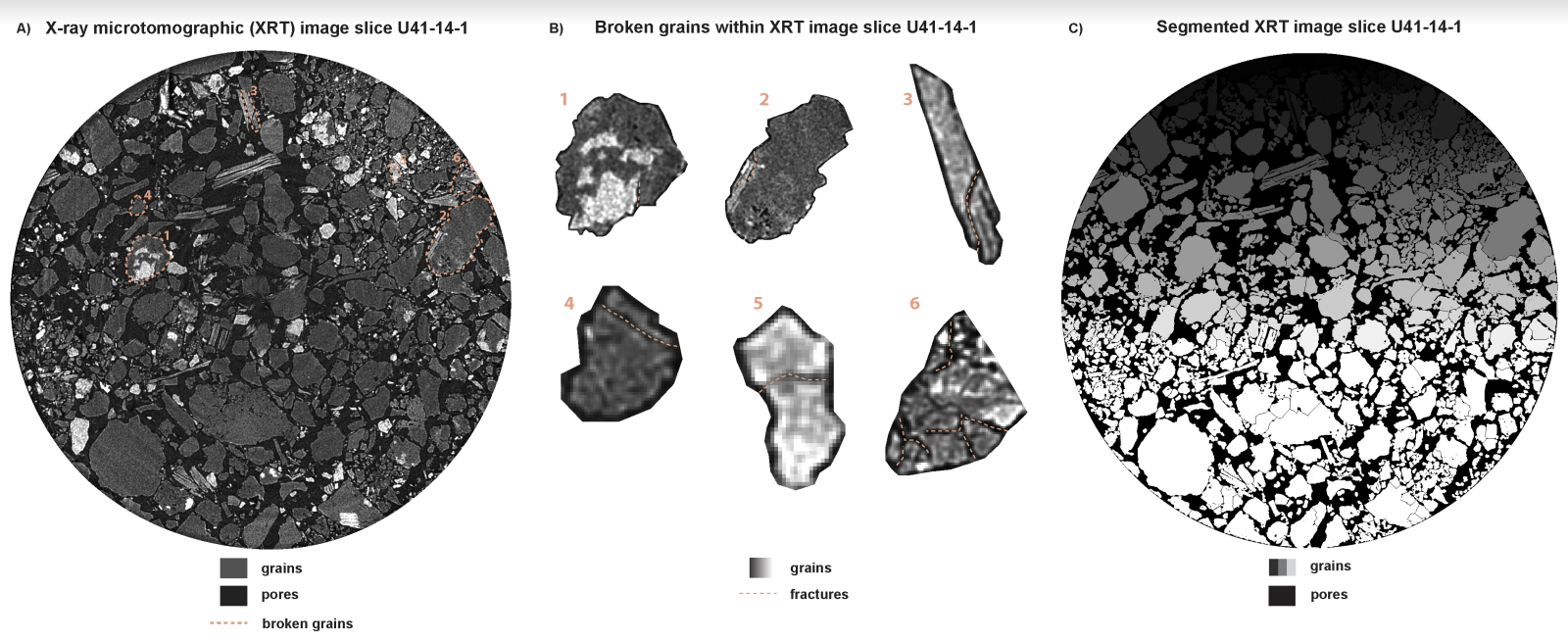
Figure 1. Figure 2 (A) X-ray computed microtomographic image slice U41-14-1 showing grains within the upper 0.0016 mm of sample. (B) Images of six fractured grains isolated from the image slice; fractured grains have not been observed in our other studies of near surface sands [8-9]. (C) Image slice after segmentation, in which grains and pores are biniarized in ImageJ for additional analysis. From such slices we can re-create the 3D arrangement of grains within the sample and compute grain and pore properties, including sphericity, angularity, porosity, bulk density, orientation, contact number, and sorting using procedures described in [8-9].
